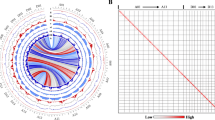Abstract
This work aims at breeding upland cotton [Gossypium hirsutum L., 2(AD)1 genome] with a reduced level of gossypol in the seeds for optimal food and feed uses, and a high gossypol level in the remaining organs for resistance to pests. Two tri-species Gossypium hybrids, (G. thurberi–G. sturtianum–G. hirsutum and G. hirsutum–G. raimondii–G. sturtianum) including G. sturtianum (2C1) as a donor, G. thurberi (2D1) and G. raimondii (2D5) as a bridge species, were created. Recurrent selection initiated with these tri-species hybrids produced backcross (BC) progenies expressing the ”low-gossypol seed and high-gossypol plant” trait at different levels. We used AFLP markers to assess the genetic similarity among the germplasm and RFLP probes to tag the introgression of specific chomosome segments from the parental species. Five pairs of AFLP primers generated 477 fragments, among which 417 (87.4%) were polymorphic. The genetic similarity between the upland cotton and the wild species ranged from 29.5 to 43.2%, while similarity reached 80% between upland cotton and BC3 plants. Introgression of species-specific AFLPs was evident from all the parental species and confirmed the hybrid origin of the analyzed progenies. Southern-blot analysis based on 49 RFLP probes allowed us to trace the introgression of parental DNA segments in the tri-species hybrids and in three generations of backcross. Introgression was evident from 11, 8 and 7 linkage groups of G. sturtianum, G. raimondii and G. thurberi respectively. The types of introgression revealed by RFLP probes are discussed, and breeding schemes to enhance recombination are proposed. The ability to trace DNA segments of known chromosomal locations from the donor G. sturtianum through segregating generations is a starting point to map the ”low-gossypol seed and high-gossypol plant” traits.
Similar content being viewed by others
Author information
Authors and Affiliations
Additional information
Received: 5 January 1999 / Accepted: 17 June 1999
Rights and permissions
About this article
Cite this article
Vroh Bi, I., Maquet, A., Baudoin, JP. et al. Breeding for ”low-gossypol seed and high-gossypol plants” in upland cotton. Analysis of tri-species hybrids and backcross progenies using AFLPs and mapped RFLPs. Theor Appl Genet 99, 1233–1244 (1999). https://doi.org/10.1007/s001220051329
Issue Date:
DOI: https://doi.org/10.1007/s001220051329




